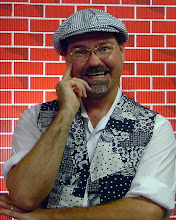The Scientific Method for Choosing a Puppet

There are two theories that can be used for choosing, or better yet designing, a puppet that people can relate with. One is “The Magic Triangle” and the other is “The Uncanny Valley”.
First, The Magic Triangle is a technique Jim Henson used in designing puppets for television. He was the first person to realize that eye contact is important, even for a puppet. His characters were designed to look right into the television camera. What the Magic Triangle refers to is an imaginary triangle that can be drawn from the characters pupils to the characters nose. The sides of the triangle should be equal. Ernie, on Sesame Street, is a perfect example of this. Ernie’s eyes are actually crossed. However, they are only crossed enough to give the illusion that he is looking right at the child watching television at home. The Magic Triangle has a significant psychological impact on anyone watching the puppet. Public speakers maintain eye contact with their audience. This is just as important for puppets.
Second, the Uncanny Valley is a principle concerning the emotional response of humans to non-human entities. It was theorized by Japanese roboticist Masahiro Mori in 1970. It says that the more human-like a non human ententy is the more we can relate with it. However there is a point where a non-human object becomes too human-like and we are repulsed by it. If an object is nonhuman, but hase some human characteristics, then we notice the human-like characteristics and we are attrcted to it. However, if an object appears almost human then we notice the features that make it non-human and it appears strange to us. A teddy bear is a non human object. It has eyes and a mouth so we are attracted to it. A corps looks human, but we immediately notice the characteristics that make it non-living, so it makes us feel uneasy. This is why puppets that are more cartoon-like are more desirable than realistic looking ventraliquist dummies.
Mori’s theory also states that movement implies life. His familuarity chart changed dramatically when the non-human object was animated. Acording to his chart, we are very atracted to Bunraku puppets, because they move so much like a humans.
So, a puppet that can make eye contact, moves in a believable manner, and is realistic, but not maniquin-like is a likable character that people can relate with.




